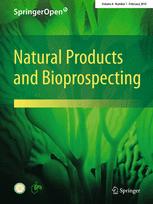|
|
Identification of enzymes responsible for the reduction of geraniol to citronellol
Collect
Tian-Tian YUAN, Qian-Qian CHEN, Pei-Ji ZHAO, Ying ZENG, Xiao-Zhu LIU, Shan LU
Natural Products and Bioprospecting. 2011, 1 (3): 108-111.
DOI: 10.1007/s13659-011-0032-6
The reduction of geraniol to citronellol is the first step for the synthesis of natural phytol in the production of tocopherols and natural vitamin K. Baker's yeast was used in the bioreduction described above as a whole-cell biocatalyst. However, the enzyme responsible for the reduction of geraniol to citronellol is not yet known. Four old yellow enzyme(OYE) genes were cloned from yeast and plants, and expressed in Escherichia coli for a high level of recombinant proteins. The recombinant protein displayed a catalytic activity of converting geraniol to citronellol as a sole product verified by GC-MS analyses. The recombinant OYE2 intact cells were found to show 3. 7 and 1. 9-fold higher activity than that of yeast cells and the recombinant crude extracts, respectively. Compared to the recombinant fusion enzyme, the entrokinase-cleaved enzyme displayed nearly identical activity for geraniol reduction. To our knowledge, this is the first enzyme identified to catalyze the formation of citronellol from geraniol by reducing the allylic alcohol double bond, which is normally known as inactivating group for the old yellow enzymes.
References |
Related Articles |
Metrics
|
|
|
Beauvericin production by the Lepidoptera pathogenic fungus Isaria tenuipes:Analysis of natural specimens, synnemata from cultivation, and mycelia from liquid-media fermentation
Collect
Sumalee SUPOTHINA, Urarat SRISANOH, Sutichai NITHITHANASILP, Kanoksri TASANATHAI, J. Jennifer LUANGSA-ARD, Chun-Ru LI, Masahiko ISAKA
Natural Products and Bioprospecting. 2011, 1 (3): 112-115.
DOI: 10.1007/s13659-011-0038-0
Beauvericin was analyzed in three forms of the Lepidoptra pathogenic fungus Isaria tenuipes(4 isolates):(a) natural specimen,(b) cultivated synnemata on rice media, and(c) mycelia from fermentation in liquid media. Beauvericin was detected in very low amounts in all tested natural specimens. Synnemata on rice contained much higher concentrations of beauvericin than the corresponding natural materials, although the concentrations were lower than mycelia from liquid fermentation. The results casted a caution that beauvericin concentration should be carefully checked, as a possible toxic constituent, upon mass production of a selected strain of Isaria tenuipes for health food purposes.
References |
Related Articles |
Metrics
|
|
|
Isorosthornins A-C, new ent-kaurane diterpenoids from Isodon rosthornii
Collect
Rui ZHAN, Xue DU, Jia SU, Xiao-Nian LI, Wei-Guang WANG, Cheng-Qin LIANG, Jian-Hong YANG, Yan LI, Jian-Xin PU, Han-Dong SUN
Natural Products and Bioprospecting. 2011, 1 (3): 116-120.
DOI: 10.1007/s13659-011-0031-7
Three new ent-kauranoids, isorosthornins A-C(1-3), and a new natural product, dihydroponicidin(4), together with five known ones were isolated from the aerial parts of Isodon rosthornii. The structures were determined by means of extensive spectroscopic analysis. All diterpenoids isolated were evaluated for their cytotoxicity against HL-60, SMMC-7721, A-549, MCF-7, and SW480 cell lines, and compounds 5 and 7 showed significant inhibitory effects on all cell lines.
References |
Related Articles |
Metrics
|
|
|
Four new isoflavanones from Tadehagi triquetrum
Collect
Rong-Ting ZHANG, Gui-Guang CHENG, Tao FENG, Xiang-Hai CAI, Xiao-Dong LUO
Natural Products and Bioprospecting. 2011, 1 (3): 121-123.
DOI: 10.1007/s13659-011-0033-5
Four new isoflavanones with isoprenoid units, named triquetrumones E-H(1-4), were isolated from the whole plants of Tadehagi triquetrum. The structures were elucidated on the basis of spectroscopic analyses, including application of MS, UV, IR, 1D and 2D NMR spectroscopic techniques.
References |
Related Articles |
Metrics
|
|
|
Dammarane-type saponins from steamed leaves of Panax notoginseng
Collect
Qing LIU, Jun-Jiang LV, Min XU, Dong WANG, Hong-Tao ZHU, Chong-Ren YANG, Ying-Jun ZHANG
Natural Products and Bioprospecting. 2011, 1 (3): 124-128.
DOI: 10.1007/s13659-011-0036-2
Four new dammarane-type triterpenoid saponins, namely notoginsenosides SFt1-SFt4(1-4) were isolated from the steamed leaves of Panax notoginseng(Burk.) F. H. Chen(Araliaceae), together with 17 known saponins. Their structures were established on the basis of detailed spectroscopic analyses and acidic hydrolysis. The known ginsenosides Rk2 and Rh3 were obtained from P. notoginseng for the first time. All of these new saponins showed no in vitro cytotoxicity against five human cancer cell lines(HL-60, SMMC-7712, A-549, MCF-7, and SW480).
References |
Related Articles |
Metrics
|
|
|
Norsesquiterpenoids from the leaves of Croton tiglium
Collect
Wei BU, Yan-Ni SHI, Yong-Ming YAN, Qing LU, Guang-Ming LIU, Yan LI, Yong-Xian CHENG
Natural Products and Bioprospecting. 2011, 1 (3): 134-137.
DOI: 10.1007/s13659-011-0035-3
Two new compounds, badounoids A(1) and B(2), together with 13 known norsesquiterpenes, were isolated from the leaves of Croton tiglium L. The structures of the new compounds were established by means of spectroscopic methods. The absolute configuration of badounoid B was determined by single-crystal X-ray diffraction analysis. All the known compounds were isolated from Croton plants for the first time which added a new chemical facet for this genus. The selected compounds were evaluated for their cytostatic activity against several cancer cell lines. None of them was found to be active.
References |
Related Articles |
Metrics
|
|

